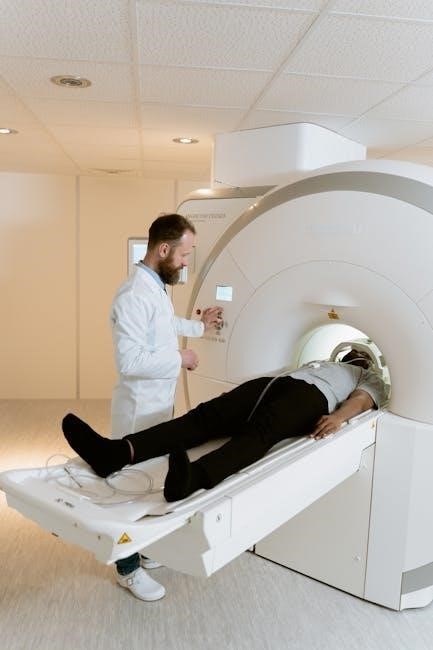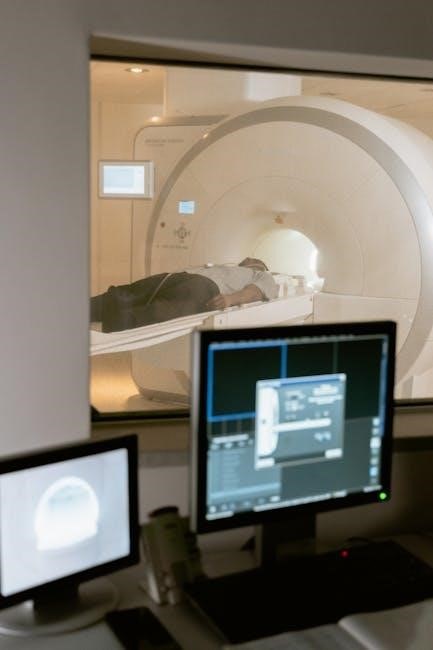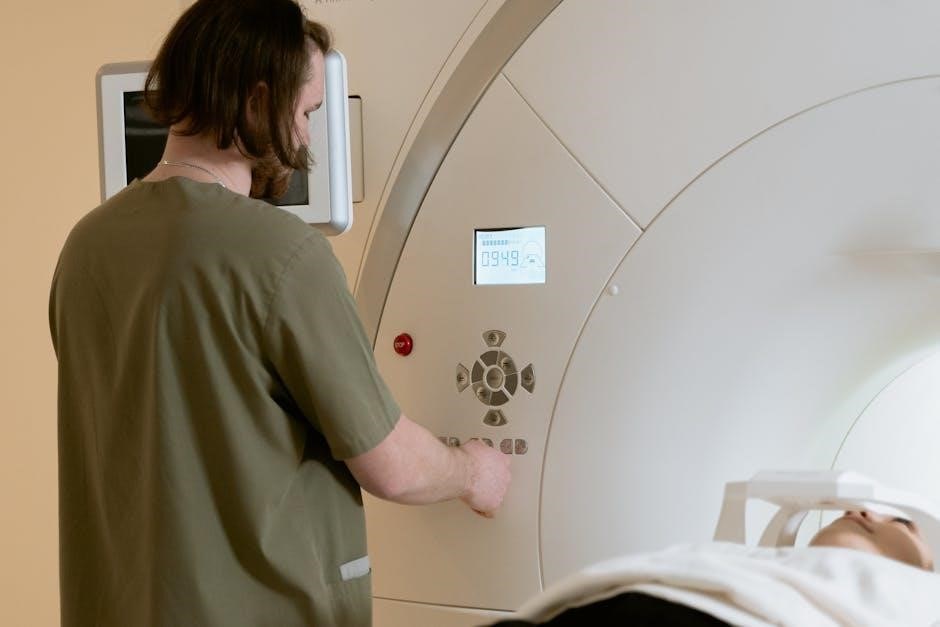Understanding the PALS Assessment
The PALS Assessment is a systematic approach to evaluating pediatric emergencies, focusing on ABCDE assessment, BLS, algorithms, and team dynamics․ It emphasizes early intervention and effective techniques like CPR and defibrillation to improve patient outcomes, designed for healthcare providers to enhance their skills in critical situations․
What is PALS?
Pediatric Advanced Life Support (PALS) is a specialized training program designed for healthcare providers to manage life-threatening emergencies in children․ It focuses on systemic approaches, basic life support, and advanced care algorithms․ PALS emphasizes early intervention and effective techniques like CPR and defibrillation․ The course uses simulations and real-life scenarios to teach participants how to identify lethal rhythms, conduct rapid cardiopulmonary assessments, and apply treatment algorithms for conditions such as pulseless arrest, bradycardia, and tachycardia․ Additionally, it covers vascular access, medication administration, and ECG interpretation, ensuring providers can deliver timely and appropriate interventions․ PALS aims to enhance critical thinking and practical skills, ultimately improving outcomes for pediatric patients in critical situations․
Purpose of the PALS Assessment
The primary purpose of the PALS assessment is to evaluate healthcare providers’ ability to manage pediatric emergencies effectively․ It ensures that participants can systematically assess children using the ABCDE approach, identify life-threatening conditions, and apply appropriate interventions․ The assessment focuses on verifying proficiency in PALS algorithms, effective resuscitation techniques, and the use of diagnostic tools․ By testing knowledge and skills, the PALS assessment aims to enhance patient care quality and improve outcomes in critical situations․ It also identifies areas for further training, ensuring that providers are well-prepared to handle emergencies involving children․ The assessment serves as a critical tool for maintaining competency in pediatric advanced life support․
Target Audience for PALS
The PALS assessment is designed for healthcare professionals who regularly encounter pediatric emergencies․ This includes pediatricians, emergency medicine physicians, critical care nurses, and paramedics․ The course is also beneficial for respiratory therapists and other specialists involved in pediatric care․ The primary goal is to equip these professionals with the skills to manage cardiac arrests, recognize lethal rhythms, and perform interventions effectively․ By targeting this audience, the PALS assessment ensures that healthcare providers are proficient in applying life-saving techniques during critical situations involving children․ The assessment is particularly valuable for those who need to enhance their ability to work in high-stress environments and make quick, accurate decisions to improve patient outcomes․

Structure of the PALS Course
The PALS course combines pre-course preparation, interactive classroom sessions, and realistic simulations to teach pediatric emergency assessment and interventions․ It includes hands-on training and assessment methods to ensure proficiency․

Pre-Course Preparation
Pre-course preparation is essential for success in the PALS course․ Participants must complete a precourse self-assessment test to evaluate their knowledge of ECG rhythm identification, pharmacology, and pediatric advanced life support concepts․ This self-assessment helps identify knowledge gaps and ensures readiness for the classroom sessions․ Additionally, students are required to review the PALS Provider Manual and complete any assigned online modules before attending the course․ The preparation focuses on understanding the ABCDE assessment approach, PALS algorithms, and effective resuscitation techniques․ It also emphasizes the importance of team dynamics and communication in pediatric emergencies․ Proper preparation ensures that participants are well-equipped to engage actively in simulations and discussions during the course․
Classroom Sessions and Simulations
Classroom sessions in the PALS course are interactive and include video-based instruction, lectures, and hands-on simulations․ These sessions focus on applying the ABCDE assessment approach, recognizing lethal rhythms, and mastering PALS algorithms․ Simulations mimic real-life pediatric emergencies, allowing participants to practice resuscitation techniques, such as CPR and defibrillation, in a controlled environment․ Team dynamics and communication are emphasized, with scenarios designed to improve decision-making and leadership skills․ Instructors provide feedback to refine participants’ abilities in managing cardiac arrest cases, including those involving pulseless ventricular tachycardia and ventricular fibrillation․ The simulations reinforce the systematic approach to patient care, ensuring preparedness for high-pressure situations․ This hands-on training enhances the retention of critical skills necessary for effective pediatric advanced life support․
Assessment Methods
The PALS course incorporates various assessment methods to evaluate participants’ understanding and skills․ A Precourse Self-Assessment is required, covering rhythm identification and pharmacology, with a minimum score of 70% to proceed․ Practice tests and self-assessment tools are available to help prepare for the final evaluation․ The course includes hands-on simulations and case-based discussions to assess practical skills in pediatric emergencies․ Participants must demonstrate proficiency in applying PALS algorithms, performing resuscitation techniques, and managing cardiac arrest scenarios effectively․ The assessments ensure that healthcare providers can identify and intervene in life-threatening situations confidently and accurately, adhering to the latest AHA guidelines and protocols․

Key Components of the PALS Assessment
The PALS Assessment focuses on the ABCDE approach, PALS algorithms, and effective resuscitation techniques․ It emphasizes systematic evaluation and intervention in pediatric emergencies to improve patient outcomes․

Primary Assessment (ABCDE Approach)
The Primary Assessment in PALS utilizes the ABCDE approach: Airway, Breathing, Circulation, Disability, and Exposure․ This systematic method ensures rapid identification of life-threatening conditions․ Airway assessment checks for patency and obstruction, while Breathing evaluates respiratory rate and effort․ Circulation focuses on pulse, perfusion, and cardiac function․ Disability involves neurological evaluation using the AVPU scale․ Exposure ensures a thorough physical examination for hidden injuries or conditions․ This approach is critical for prioritizing interventions and stabilizing the patient․ It is emphasized in PALS training to facilitate quick decision-making and effective care in pediatric emergencies․ The ABCDE method is integral to the PALS framework, guiding healthcare providers to address the most critical issues first, ensuring timely and appropriate interventions․

PALS Algorithms and Treatment
PALS algorithms provide structured approaches for managing pediatric emergencies, focusing on conditions like pulseless arrest, bradycardia, and tachycardia․ These evidence-based protocols guide healthcare providers in delivering timely interventions․ For pulseless arrest, the algorithm emphasizes high-quality CPR and defibrillation․ Bradycardia treatment involves assessing perfusion and administering medications like epinephrine if necessary․ Tachycardia algorithms differentiate between stable and unstable patients, recommending interventions such as synchronized cardioversion or medication․ The PALS treatment framework stresses early recognition and intervention, ensuring care aligns with the child’s clinical condition․ These algorithms are designed to be straightforward, enabling quick decision-making during high-stress situations․ Adherence to these guidelines improves outcomes by standardizing care and reducing variability in treatment approaches․
Effective Resuscitation Techniques
Effective resuscitation techniques in PALS emphasize high-quality CPR, proper ventilation rates, and timely defibrillation․ The American Heart Association (AHA) guidelines stress the importance of maintaining a compression rate of 100-120 BPM and allowing adequate chest recoil․ Ventilation should be provided at 12-20 breaths per minute to avoid over-inflation․ Defibrillation is critical for shockable rhythms like ventricular fibrillation or pulseless ventricular tachycardia, with an initial dose of 2-4 Joules/kg․ Medications, such as epinephrine, are administered to support cardiac function․ Effective techniques also involve continuous ECG monitoring to identify and address lethal arrhythmias promptly․ Proper oxygenation and perfusion are prioritized to prevent further deterioration․ These methods ensure a systematic and evidence-based approach to resuscitation, improving outcomes for pediatric patients in critical situations․

Diagnostic Tools and Interventions

Diagnostic tools in PALS include ECG monitoring, pulse checks, and blood pressure assessments․ Interventions focus on maintaining airway patency, ensuring adequate oxygenation, and appropriate medication administration․
Vascular Access and Medication
Vascular access is critical in PALS for administering medications and fluids․ Common methods include intravenous (IV) and intraosseous (IO) access․ Medications like epinephrine and amiodarone are key in cardiac arrest scenarios․ Proper technique ensures effective drug delivery․ Monitoring and titrating medications based on patient response is essential․ Vascular access and medication administration are vital skills for improving outcomes in pediatric emergencies․

ECG Interpretation and Rhythm Identification
ECG interpretation is a cornerstone of PALS, enabling providers to identify life-threatening rhythms such as pulseless arrest, bradycardia, and tachycardia․ Accurate rhythm identification guides treatment algorithms, ensuring timely interventions․ The PALS course emphasizes recognizing patterns like ventricular fibrillation (VF) and pulseless ventricular tachycardia (VT), which are critical in pediatric cardiac arrest․ Providers learn to interpret ECGs to differentiate between respiratory and cardiac causes of distress․ This skill is reinforced through self-assessment tools and practice tests, allowing healthcare professionals to refine their ability to swiftly and accurately diagnose rhythm abnormalities․ Proficiency in ECG interpretation is vital for delivering appropriate care and improving patient outcomes in high-stakes pediatric emergencies․

PALS Assessment Resources
Official PALS Assessment PDF materials provide comprehensive guides, algorithms, and self-assessment tools․ Practice tests and rhythm identification exercises enhance preparation for real-world pediatric emergencies, ensuring proficiency in critical care skills․
Official PALS Assessment PDF Materials
The official PALS Assessment PDF materials are comprehensive resources designed to guide healthcare providers in mastering pediatric emergency care․ These documents include detailed algorithms, step-by-step instructions, and case scenarios to enhance learning․ The PDFs cover essential topics such as the ABCDE approach, rhythm identification, and resuscitation techniques․ They also provide practice exercises and self-assessment tools to test knowledge and preparedness․ These materials are regularly updated to align with the latest American Heart Association (AHA) guidelines, ensuring evidence-based practices․ The PDFs are accessible for download from the AHA website or authorized training centers, serving as invaluable study aids for professionals aiming to excel in pediatric advanced life support․ They are structured to be user-friendly, making complex concepts easy to understand and apply in real-world situations․
Practice Tests and Self-Assessment Tools
Practice tests and self-assessment tools are essential for preparing for the PALS assessment․ These resources allow healthcare providers to evaluate their knowledge and skills in pediatric emergency care․ The PALS Precourse Self-Assessment (PSA) is a key component, covering topics like rhythm identification, pharmacology, and algorithms․ It helps identify areas needing improvement before the actual course․ Additionally, online practice tests simulate real exam conditions, featuring multiple-choice questions and case-based scenarios; Self-assessment tools, such as ECG rhythm identification tests, enhance proficiency in critical skills․ These resources align with the official PALS curriculum, ensuring comprehensive preparation․ Regular use of these tools improves decision-making and confidence in high-stakes situations, ultimately enhancing patient care outcomes․ They are available in PDF and digital formats for convenience and accessibility․